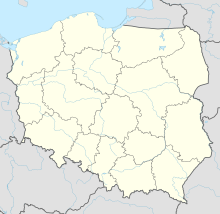Wawel Royal Castle
| Wawel Royal Castle | |
|---|---|

Night view of the castle
|
|
| Type | Castle residency |
| Location | Old Town, Kraków, Poland |
| Coordinates | 50°03′14″N 19°56′05″E / 50.05389°N 19.93472°ECoordinates: 50°03′14″N 19°56′05″E / 50.05389°N 19.93472°E |
| Area | 7,040 m2 (0.704 ha) |
| Built | 13th and 14th centuries |
| Architectural style(s) | Romanesque, Gothic, Renaissance, Early Baroque |
| Visitors | 1,500,000 (in 2015) |
| Owner |
List of owners:
|
| Website | Official Website |
| Official name: Historic Centre of Kraków | |
| Type | Cultural |
| Criteria | IV |
| Designated | 1978 (2nd session) |
| Reference no. | [1] |
| Country | Poland |
| Region | Europe and North America |
The Wawel Castle is a castle residency located in central Kraków, Poland. Built at the behest of King Casimir III the Great, it consists of a number of structures situated around the Italian-styled main courtyard. The castle, being one of the largest in Poland, represents nearly all European architectural styles of medieval, renaissance and baroque periods. The Wawel Royal Castle and the Wawel Hill constitute the most historically and culturally significant site in the country. In 1978 it was declared a UNESCO World Heritage Site as part of the Historic Centre of Kraków.
For centuries the residence of the kings of Poland and the symbol of Polish statehood, the Castle is now one of the country’s premier art museums. Established in 1930, the museum encompasses ten curatorial departments responsible for collections of paintings, including an important collection of Italian Renaissance paintings, prints, sculpture, textiles, among them the Sigismund II Augustus tapestry collection, goldsmith’s work, arms and armor, ceramics, Meissen porcelain, and period furniture. The museum’s holdings in oriental art include the largest collection of Ottoman tents in Europe. With seven specialized conservation studios, the museum is also an important center for the conservation of works of art.
People have lived on Wawel Hill at the site of the Castle as early as fifty thousand years ago, in the Paleolithic Age. The settlement was apparently bustling with trade, assorted crafts and local farming. When more people began to settle down on the Wawel Hill and when trade became more efficient, the rulers of Poland took up their residence at the Hill as well.
During the early 16th century King Sigismund I the Old (Zygmunt I in Polish) and his wife brought in the best native and foreign artists including Italian architects, sculptors, and German decorators, to refurbish the castle into a splendid Renaissance palace. It soon became a paragon of stately residence in Central and Eastern Europe and served widely as a model throughout the region.
...
Wikipedia

